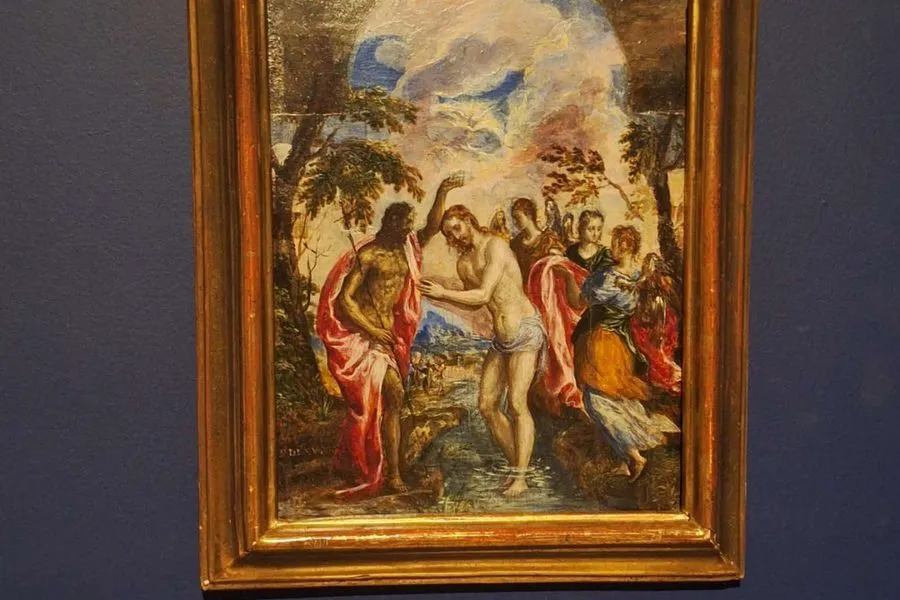El Greco’s celebrated painting The Baptism of Christ is traveling to Venice, Italy, to be featured in the major temporary exhibition Painted Gold: El Greco and the Veneto-Cretan School.
The exhibition will be hosted at the Doge’s Palace in Venice from April 26 to September 29, 2025. It aims to revive the spiritual and artistic bond between Crete and Venice during the Venetian rule of the island. More than seventy works of art from leading Greek and European museums and collections will be on display, showcasing the richness of the so-called Veneto-Cretan School. The curators of the exhibition are Andrea Bellieni, Katerina Dellaporta, and Chiara Squarcina, and several other works from Greece will also be featured. This makes the exhibition a particularly significant international cultural event centered on the Venetian-Cretan painting tradition.
A Masterpiece’s Journey
Painted between 1567 and 1569, The Baptism of Christ is one of the earliest known works by Doménikos Theotokópoulos, widely known as El Greco. Executed in egg tempera and oil on wood, the painting measures 23.5 by 18.1 cm and showcases the artist’s formative style, blending post-Byzantine traditions with Western influences. The artwork bears a close resemblance to the baptism panel of El Greco’s Modena Triptych (1568), highlighting his evolving artistic vision during his time in Venice
For years, the painting resided outside of Crete, its whereabouts a subject of intrigue among art historians and enthusiasts. Its return is not just the repatriation of a significant artwork but a restoration of a piece of Cretan identity.
A Collective Effort
The journey to bring The Baptism of Christ back to Crete was marked by a remarkable communal endeavor. In 2004, upon learning that the painting was up for auction, the people of Crete united in a fundraising campaign to acquire it.Children, union members, businesspeople, and churchgoers contributed, with priests even advocating for donations during sermons. Banks provided loans to support the cause, reflecting the islanders’ profound desire to reclaim a work by their most illustrious native artist .
Manolis Vassilakis, overseeing the fundraising efforts, expressed the sentiment driving the campaign: “He is the most important person Crete has ever produced. It upsets us that so many think he is from Spain.” This collective action underscored the community’s commitment to preserving and celebrating their cultural heritage.
Homecoming to the Historical Museum of Crete
Today, The Baptism of Christ is proudly displayed at the Historical Museum of Crete in Heraklion. Founded in 1953, the museum offers a comprehensive overview of Cretan history and art from the early Christian era to the modern day.Alongside The Baptism of Christ, the museum houses another original El Greco painting, View of Mount Sinai (1570–1572), making it the only institution in Crete with original works by the artist .
Visitors to the museum can explore a diverse collection that includes ceramics, sculptures, coins, and manuscripts, as well as exhibits dedicated to notable Cretan figures like writer Nikos Kazantzakis. The inclusion of El Greco’s works offers a unique opportunity to appreciate the early development of an artist who would later leave an indelible mark on the art world.
A Cultural Renaissance
The return of The Baptism of Christ to Heraklion is more than a homecoming; it’s a testament to the enduring legacy of El Greco and the island’s dedication to honoring its cultural icons. For residents and visitors alike, the painting serves as a bridge between Crete’s rich past and its vibrant present, inviting all to engage with the island’s artistic heritage.
As you stroll through the Historical Museum of Crete, standing before The Baptism of Christ, you’re not just viewing a masterpiece; you’re witnessing the culmination of a community’s passion and pride in reclaiming a piece of their history.


